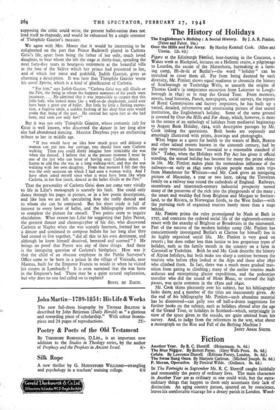The History of Holidays
The Englishman's Holiday : A Social History. By J. A. R. Pimlott. (Faber and Faber. 16s.)
Figaro at the Edinburgh •F4stival, bear-hunting in the Caucasus, a Wakes week at Blackpool, lectures on a Hellenic cruise, a pilgrimage to Lourdes, the ascent of the Matterhorn, haymaking at a farm- ing camp, Hi-de-hi at Butlin's—the word " holiday " can be stretched to cover them all. Far from being daunted by such diversity, Mr. Pimlott shows equal readiness to chronicle the history of Scarborough or Tunbridge Wells, to unearth the origins of Thomas Cook's (a temperance excursion from Leicester to Lough- borough in 1841) or to map the Grand Tour. From memoirs, novels, local histories, Punch, newspapers, social surveys, the reports of Royal Commissions and factory inspectors, he has built up a varied, detailed, informative and entertaining picture of that sacred institution, the Englishman's holiday. Some of the same ground is covered by Over the Hills and Far Away, which, however, is more in the nature of an anthology of holidays from mediaeval beginnings to August Bank Holiday, 1914, with descriptive passages by Mr. Cook linking the quotations. Both books are copiously and amusingly illustrated with prints, drawings and photographs.
What began as a quest for health to the waters of Bath, Buxton and other inland resorts known in the sixteenth century, had by the early twentieth become " essential to a reasonable standard of life." Today, when the Holidays with Pay Act has given it official standing, the annual holiday has become for many the prime object in life. Mr. Pimlott makes plain the tremendous influence of the railways—as early as 1845 some 156,000 people made train trips from Manchester for Whitsun—and Mr. Cook gives an intriguing picture of Macaulay, a year or two later,. taking the Trevelyan family on a railway tour round the cathedrals of England. Railways, steamboats and nineteenth-century industrial prosperity turned many of the preserves of the rich into the playgrounds of the many ; the smart and wealthy fled from Brighton and Margate to Switzer- land, to the Riviera, to Norwegian fjords, to the West Indies—with the pursuing mob of organised tourists barely more than a stage behind.
Mr. Pimlott prints the rules promulgated by Nash at Bath in 1707, and contrasts the ordered social life of the eighteenth-century resort with the anarchy of Brighton or Broadstairs in the nineteenth. Part of the success of the modern holiday camp (Mr. Pimlott has conscientiously investigated Butlin's at Clacton for himself) lies in its highly organised social life. Mr. Pimlott is very good on resorts ; but does rather less than justice to less gregarious types of holiday, such as the family month in the country on a farm in Cornwall or Yorkshire. Both he and Mr. Cook describe the history of Alpine holidays, but both make too sharp a contrast between the tourists who before 185o looked at the Alps and those after 1850 who climbed them. In fact, there was a much more gradual tran- sition from gazing to climbing ; many of the earlier tourists made arduous and enterprising glacier expeditions, and the pedestrian traveller who did the round of Mont Blanc, or crossed the high passes, was quite common in the 183os and 184os. Mr. Cook skims pleasantly over his subject, but his bibliography lacks dates and, number of the titles are inaccurately given. At the end of his bibliography Mr. Pimlott—such abundant material has he discovered—can gaily toss off half-a-dozen suggestions for further books on the subject, such as holidays abroad after the age of the Grand Tour, or holidays in Scotland—which, surprisingly in view of the space given.to the seaside, are quite omitted, from his survey. And, to judge from the references in the text, what about a monograph on the Rise and Fall of the Bathing Machine ?
JANET ADAM SMITH.


































 Previous page
Previous page